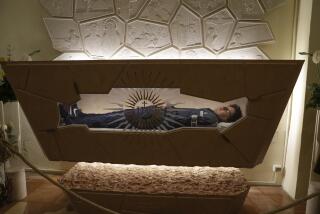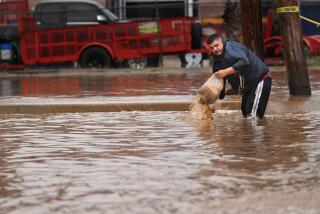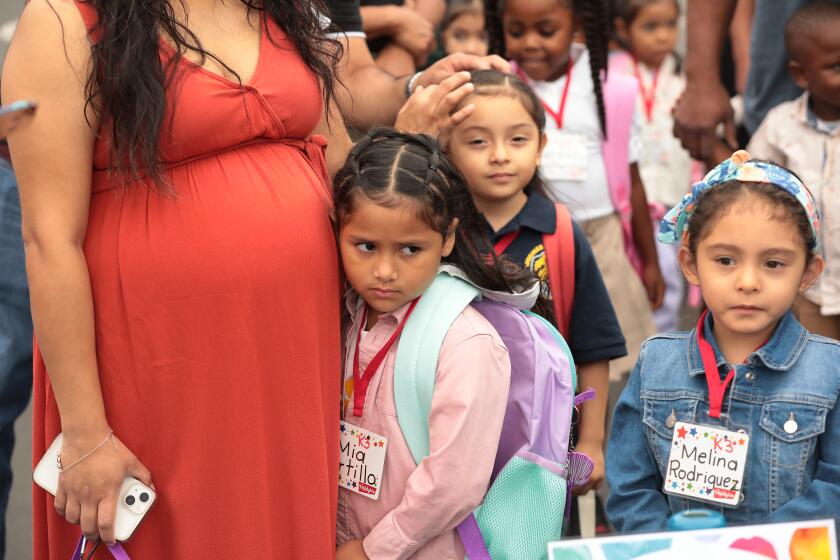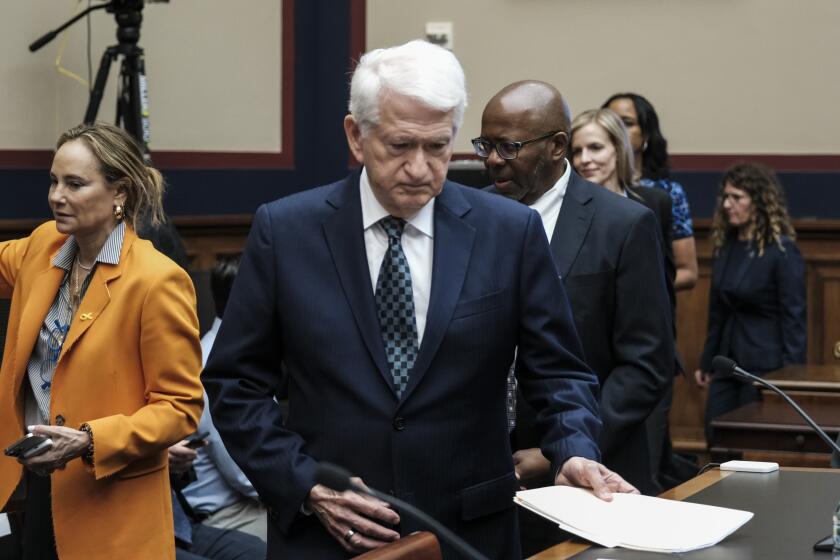Where Chaos Is Expelled
Tyne Thompson and Grant Amann are two of the thousands of children picked up by Hurricane Katrina and plopped down in this big inland city, safely outside the track of monster storms.
Tyne, 17, is poor and black. Grant, 6, is affluent and white. Their families took different paths to get here. One left New Orleans in a roomy sport utility vehicle with enough time for his family to grab the ashes of their beloved yellow Labrador. The other escaped the fetid Superdome on a packed bus that wouldn’t let Lady, the family’s 4-year-old German shepherd, on board.
They landed mere miles apart in north Dallas, where one of the wealthiest school districts in the country abuts one of the poorest. It would be easy to assume that one child tumbled into clover and the other into further despair. But the fact is, the public schools they entered have become a refuge for both, helping them through a difficult odyssey that is far from over.
Every weekday morning, Tyne gets up at 6, eats breakfast standing up -- there is little furniture in the apartment -- then takes two public buses and a train to Madison High School. The lawn there is brown and there is a metal detector at the front entrance. The school is classified as “low-performing.” But what Tyne found there was a crisp uniform, a no-nonsense principal with an open door and an honors English class in which she is earning an A.
On those same mornings, a few miles away, Grant heads to kindergarten at John S. Armstrong Elementary, one of the highest-rated in Texas. It has manicured lawns and lockers the color of lemon drops. The stress of leaving behind his friends and his Rescue Hero toys is fading, and Grant has recently achieved a milestone: He has learned to read.
Both families are struggling and unsettled, victims of failed levees or a botched rescue effort. But for all that went wrong during that terrible week at the end of summer, the public schools were the one segment of government that rose to the challenge for many of the estimated 372,000 displaced children, regardless of their race or class.
“I got calls from all over the country saying, ‘We’ll take the kids,’ ” said Paul Houston, executive director of the American Assn. of School Administrators in Virginia. “Voluntarily, massively, all these districts have taken them in, and you don’t hear that there’s some huge mess. They are making it work.”
Across the country, schools absorbed traumatized children who had witnessed death, suffered loss and gone hungry. They dispatched abuse and trauma counselors, hired teachers, enlisted tutors and found extra textbooks. Tight budgets were stretched ever tighter. Here, the Dallas Independent School District -- Texas’ largest and one of its poorest-performing -- took in more than 2,400 Katrina evacuees. Highland Park Unified -- prestigious and mostly white -- got 53.
Like Tyne, virtually all the Dallas Independent children came through shelters. Like Grant, virtually all the Highland Park students escaped with their parents before the flood.
Not even Katrina could shake up the solid class divisions of New Orleans.
*
Five Moves in a Month
In the pocket of Tyne’s khaki pants is a little white card her mother gave her listing the family’s latest address and telephone number. When a girl moves five times in a month -- including a nightmarish stay at the New Orleans Superdome, where, she said, she watched a man leap to his death -- it’s hard to remember small details. Even now, climbing to the third floor of the neat but spare apartment complex where the Thompsons live, Tyne isn’t sure she has the right stairwell. They all look so much alike.
“I think this is it,” she said, relieved when she sees the familiar face of her father at the door.
Inside the residence, paid for with donations, Robin Thompson is cooking for her husband and six children what is left of some donated food -- pork chops, meatloaf and cauliflower. Tyne’s brother is watching “The Simpsons” on a secondhand television set with fuzzy reception.
Dinner is almost ready, but the table isn’t set; there is no table. The family eats in shifts. That doesn’t concern Robin, a devoted churchgoer, because they spend most evenings together on the floor, talking and reading the Bible.
Back in their 1923 duplex in the historic Holy Cross district of Orleans Parish, a sturdy four-bedroom that flooded to the rafters, Robin ran a child-care center. Her husband, Gregory, worked as a crossing guard. Together, they earned about $20,000 a year.
Robin was an involved parent -- PTA president, winner of an elementary school’s Outstanding Parent Award, a Head Start mentor. Then Katrina hit, and she took the children to the Superdome. Her husband, who can’t swim, stayed behind and nearly drowned.
The Thompson family landed in a low-income housing complex in south Dallas. Robin has managed to visit only the school that her youngest child attends, and she can’t remember the exact name of it.
It’s not the level of involvement she’s comfortable with. Still, she knows something must be going right because when they moved to the apartment, Tyne begged to stay at Madison High, even though two other schools are close by.
“I said, ‘Mom, please,’ ” Tyne recalled. “I liked it the very first day.” Now, she makes an hour’s commute on public transit with two sisters in tow.
One of the people Tyne likes best is Principal Marian Willard, a large, unflappable woman with a deep, soothing voice. She’s the sort who finds a way to get things done. Willard didn’t wait for a FEMA authorization form when she realized her new charges would need backpacks. Instead, she started calling sorority sisters from her college days, who responded on the spot. One of the backpacks went to Tyne.
Madison is a poor school in a district where 80% of the 615 children are classified as needy. Katrina made its problems worse.
When offers to help the hurricane victims began to pour in from around the state, Dallas school board Trustee Ron Price insisted that some of the charity be shared with local children. Several beauticians who offered free hairstyling to New Orleans students balked.
“I haven’t heard back from those particular beauticians,” Price said. “It’s sad when you see people volunteer to help poor children, but they select which poor children to help.”
Many of the hurricane evacuees who arrived in Dallas were already behind in reading and math. Many students who spent time in shelters showed signs of trauma: hoarding food in the cafeteria, bathroom accidents, crying, difficulty focusing, attendance problems. Fights have broken out between New Orleans and local students in a handful of high schools in Dallas and Houston.
Most of the children arrived without academic or medical records, so each was assessed by a counselor. Support groups were created at 50 campuses that took in Katrina evacuees, said Associate Supt. Rosemarie Allen, a psychologist in charge of mental health programs.
“Kids in some schools, particularly high schools, are having some behavior problems. Whether or not that was true when they left New Orleans or if it’s a symptom of stress, I can’t tell you that,” Allen said.
The extra tutoring, supplies and services needed to support the new students have cost twice what the district expected, Allen said. Federal funds have been promised but are slow in coming, and no district can be sure of how much it will receive.
Even on a shoestring, Madison High seems to be having success.
“Something good is going on here, because I have a lot of New Orleans parents from outside the [attendance] zone trying to enroll the kids,” said Willard, whom one student likened to a grandmother he didn’t want to disappoint.For Mike Williams, 17, staying at Madison meant choosing between his family and his school. He chose school. When his parents moved again to Richardson, Texas, he moved in with the family of a football teammate. His first report card put him on the dean’s honor roll.
“I surprised myself,” he said, taking a break from after-school practice. “It’s easier to focus. Here at school, every time I turn around someone is cheering for me. In New Orleans, they put me down.”
One 18-year-old student was so determined to stay that he is living in his own apartment, courtesy of the Federal Emergency Management Agency. His coaches look in on him.
And there is Tyne, who spends two hours of every day traveling.
Life for her is difficult. Her parents are struggling to find work. Her family members all wear borrowed clothes. Her mother, a powerful role model for her children, has been fighting depression. Her father spends part of every day searching for Lady, the dog who stuck by him for six harrowing days, then had to be abandoned at the Superdome with an attached note.
But Tyne says she is “adjusting well.” She finds herself sitting in the same spot in her new classes as in her old ones -- toward the back of the room -- a thread of consistency amid the chaos. Deeply religious, she considers fifth-period choir her haven.
She seems to know everyone on campus. The Dallas school board recognized her as an “outstanding student leader.” She spends so much time yakking with her new girlfriends that her mother cut off phone privileges at 8 p.m. “New Orleans will always be my home, my heart,” said Tyne, the image of her mother with the same cropped hairstyle. She misses the beignets, the cornbread, the jambalaya. “But there is nothing to go back to. And I am pretty tired of moving from place to place.”
*
Interviewing Principals
Across town, in the elegant neighborhood of Highland Park, there’s a rumor that George and Laura Bush are seeking to buy property for a post-presidential home. It isn’t hard to believe, because life is about as perfect as it gets in this little corner of Texas, where the lawns are rolling, the houses are grand and Armstrong Elementary is tucked amid streets whose names assume the children’s destiny: Harvard, Dartmouth, Cornell.
The product of private schools, the Amann family is not here by accident. As Katrina approached, they chose to head to Dallas because Laura, Grant’s mother, had attended Southern Methodist University. At the first opportunity, she got on the Internet to look for a school for Grant. Before settling on Armstrong, she interviewed the principal at length.
“In New Orleans, we don’t do public school,” Curtis, Grant’s father, explained.
Now, public school is the one thing the family has been able to count on when all else seems to be fraying. Their $6,500-a-month rental home, with the winding entry-hall staircase, has the trappings of affluence but masks the turmoil within. The rooms are sparsely furnished with a secondhand couch, some borrowed tables. The cookware consists of two pots.
Grant shares a bedroom with his 3-year-old sister Abby, a blue curtain marking his territory, a pink one marking hers. But no matter how comfortable Laura tries to make it, they cannot stay -- there is no work for her husband in Dallas.
The Amanns are lucky compared with many others displaced by Katrina. They have financial resources and education. Nevertheless, their lives are in chaos. Even the way they see themselves has changed.
When the PTA president brought over a dinner with homemade salad dressing, Laura didn’t know how to react. Always on the giving end of charity before, her family was suddenly the one in need. Between her career as a real estate broker and his selling surgical equipment, the Amanns pulled in as much as $200,000 a year. Now her job is on hold and his in flux. Curtis commutes to New Orleans during the week and sees his family mostly on weekends.
Their $650,000 home was destroyed. The paint washed off of the LeRoy Neiman that hung in the dining room. They are still on the hook for a $1,700 monthly mortgage. Aware of what happened to New Orleans’ poor, Laura is reluctant to complain. But it’s hard not to.
“We’ve lost a home that would have held a significant profit,” she said, sitting on her front steps with a laptop computer, surveying photos of the wreckage. “We’re dealing with insurance that won’t cover a third of it. We’ve lost our city, what we knew, what we grew up in, where we wanted our kids to be. We’re going to be separated from family, from my work, from friends.”
But once they found Armstrong Elementary, they were instantly swept into the fold. The annual new-parents coffee had already taken place, but the school held another for the Katrina families. Other Armstrong parents presented the newcomers with a book listing friendly restaurants, the best dry cleaner, good mechanics and reliable baby-sitters.
In the more than two months Grant spent at Armstrong, his confidence grew. He insisted on being dropped at the curb rather than walked to the school door by his mom.
Early this month, Grant moved to a suburb of Washington, D.C., where his father found a new job. Grant will attend a private school that his mother flew to Virginia to inspect.
Back in Dallas, Ms. Lisenby’s class sent Grant off with a party and a handmade book of pictures of all his friends. Laura says he won’t ever forget his short stay here.
“The only thing he absolutely could count on was getting there every day,” she said. “It gave him the only stability there was.”
More to Read
Start your day right
Sign up for Essential California for news, features and recommendations from the L.A. Times and beyond in your inbox six days a week.
You may occasionally receive promotional content from the Los Angeles Times.






